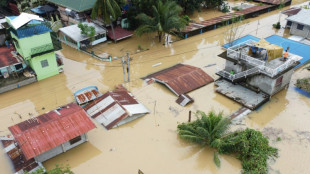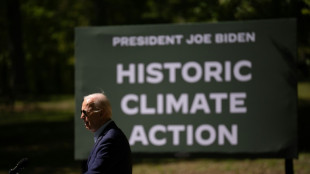
-
 Trump asks US Supreme Court to pause law threatening TikTok ban
Trump asks US Supreme Court to pause law threatening TikTok ban
-
Arsenal edge past Ipswich to go second in Premier League

-
 LawConnect wins punishing and deadly Sydney-Hobart yacht race
LawConnect wins punishing and deadly Sydney-Hobart yacht race
-
Ronaldo slams 'unfair' Ballon d'Or result after Vinicius snub

-
 Several wounded N.Korean soldiers died after being captured by Ukraine: Zelensky
Several wounded N.Korean soldiers died after being captured by Ukraine: Zelensky
-
Fresh strike hits Yemen's rebel-held capital

-
 Netflix with Beyonce make splash despite NFL ratings fall
Netflix with Beyonce make splash despite NFL ratings fall
-
Bird flu mutated inside US patient, raising concern

-
 Slovakia says ready to host Russia-Ukraine peace talks
Slovakia says ready to host Russia-Ukraine peace talks
-
Maresca challenges Chelsea to react to Fulham blow

-
 Tech slump slays Santa rally, weak yen lifts Japan stocks higher
Tech slump slays Santa rally, weak yen lifts Japan stocks higher
-
Test records for Zimbabwe and Williams as Afghanistan toil

-
 LawConnect wins punishing Sydney-Hobart yacht race
LawConnect wins punishing Sydney-Hobart yacht race
-
Barca's Yamal vows to 'come back better' after ankle injury

-
 Olmo closer to Barcelona exit after registration request rejected
Olmo closer to Barcelona exit after registration request rejected
-
Watching the sun rise over a new Damascus

-
 Malaysia man flogged in mosque for crime of gender mixing
Malaysia man flogged in mosque for crime of gender mixing
-
Montenegro to extradite crypto entrepreneur Do Kwon to US

-
 Brazil views labor violations at BYD site as human 'trafficking'
Brazil views labor violations at BYD site as human 'trafficking'
-
No extra pressure for Slot as Premier League leaders Liverpool pull clear

-
 Tourists return to post-Olympic Paris for holiday magic
Tourists return to post-Olympic Paris for holiday magic
-
'Football harder than Prime Minister' comment was joke, says Postecoglou

-
 Driver who killed 35 in China car ramming sentenced to death
Driver who killed 35 in China car ramming sentenced to death
-
Bosch gives South Africa 90-run lead against Pakistan

-
 French skier Sarrazin 'conscious' after training crash
French skier Sarrazin 'conscious' after training crash
-
NATO to boost military presence in Baltic after cables 'sabotage'

-
 Howe hopes Newcastle have 'moved on' in last two seasons
Howe hopes Newcastle have 'moved on' in last two seasons
-
German president dissolves parliament, sets Feb 23 election date

-
 Slot says 'too early' for Liverpool title talk
Slot says 'too early' for Liverpool title talk
-
Mayotte faces environment, biodiversity crisis after cyclone

-
 Amorm says 'survival' aim for Man Utd after Wolves loss
Amorm says 'survival' aim for Man Utd after Wolves loss
-
Desertions spark panic, and pardons, in Ukraine's army

-
 China sanctions US firms over Taiwan military support
China sanctions US firms over Taiwan military support
-
World number six Rybakina makes winning start at United Cup

-
 Israeli strikes hit Yemen airport as WHO chief prepares to leave
Israeli strikes hit Yemen airport as WHO chief prepares to leave
-
Swiatek not expecting WADA appeal over doping scandal

-
 'Dangerous new era': climate change spurs disaster in 2024
'Dangerous new era': climate change spurs disaster in 2024
-
Fritz motivated for Slam success after low-key off-season

-
 Move over Mercedes: Chinese cars grab Mexican market share
Move over Mercedes: Chinese cars grab Mexican market share
-
Zverev aiming to challenge Sinner for top ranking

-
 N. Korean soldier captured in Russia-Ukraine war: Seoul
N. Korean soldier captured in Russia-Ukraine war: Seoul
-
Inspired Tsitsipas looking to 'refresh, regroup' in Australia

-
 Seahawks edge Bears to boost NFL playoff hopes
Seahawks edge Bears to boost NFL playoff hopes
-
Thunder NBA win streak at nine as Shai ties career high with 45

-
 India announces state funeral for ex-PM Manmohan Singh
India announces state funeral for ex-PM Manmohan Singh
-
Japan govt approves record budget for ageing population, defence

-
 Japanese shares gain on weaker yen after Christmas break
Japanese shares gain on weaker yen after Christmas break
-
South Korea's acting president faces impeachment vote

-
 Fleeing Myanmar, Rohingya refugees recall horror of war
Fleeing Myanmar, Rohingya refugees recall horror of war
-
Smith century puts Australia in control of 4th Test against India

| RBGPF | -1.17% | 59.8 | $ | |
| RYCEF | 0.14% | 7.26 | $ | |
| CMSC | -0.85% | 23.46 | $ | |
| BCC | -1.91% | 120.63 | $ | |
| NGG | 0.66% | 59.31 | $ | |
| JRI | -0.41% | 12.15 | $ | |
| RIO | -0.41% | 59.01 | $ | |
| GSK | -0.12% | 34.08 | $ | |
| SCS | 0.58% | 11.97 | $ | |
| CMSD | -0.67% | 23.32 | $ | |
| RELX | -0.61% | 45.58 | $ | |
| VOD | 0.12% | 8.43 | $ | |
| BTI | -0.33% | 36.31 | $ | |
| BCE | -0.93% | 22.66 | $ | |
| BP | 0.38% | 28.96 | $ | |
| AZN | -0.39% | 66.26 | $ |

World's richest 1% emit as much carbon as bottom two-thirds: report
The richest one percent of the global population are responsible for the same amount of carbon emissions as the world's poorest two-thirds, or five billion people, according to an analysis published Sunday by the nonprofit Oxfam International.
While fighting the climate crisis is a shared challenge, not everyone is equally responsible and government policies must be tailored accordingly, Max Lawson, who co-authored the report, told AFP.
"The richer you are, the easier it is to cut both your personal and your investment emissions," he said. "You don't need that third car, or that fourth holiday, or you don’t need to be invested in the cement industry."
"Climate Equality: A Planet for the 99%", was based on research compiled by the Stockholm Environment Institute (SEI) and it examined the consumption emissions associated with different income groups up to the year 2019.
It was published as world leaders prepare to meet for climate talks at the COP28 summit in Dubai later this month. Fears are growing that limiting long-term warming to 1.5 degrees Celsius could soon be impossible to achieve.
Among the key findings of this study are that the richest one percent globally -- 77 million people -- were responsible for 16 percent of global emissions related to their consumption.
That is the same share as the bottom 66 percent of the global population by income, or 5.11 billion people.
The income threshold for being among the global top one percent was adjusted by country using purchasing power parity -- for example in the United States the threshold would be $140,000, whereas the Kenyan equivalent would be about $40,000.
Within country analyses also painted very stark pictures.
For example, in France, the richest one percent emit as much carbon in one year as the poorest 50 percent in 10 years.
Excluding the carbon associated with his investments, Bernard Arnault, the billionaire founder of Louis Vuitton and richest man in France, has a footprint 1,270 times greater than that of the average Frenchman.
The key message, according to Lawson, was that policy actions must be progressive.
"We think that unless governments enact climate policy that is progressive, where you see the people who emit the most being asked to take the biggest sacrifices, then we're never going to get good politics around this," he said.
These measures could include, for example, a tax on flying more than ten times a year, or a tax on non-green investments that is much higher than the tax on green investments.
While the current report focused on carbon linked only to individual consumption, "the personal consumption of the super-rich is dwarfed by emissions resulting from their investments in companies," the report found.
Nor are the wealthy invested in polluting industries at a similar ratio to any given investor -- billionaires are twice as likely to be invested in polluting industries than the average for the Standard & Poor 500, previous Oxfam research has shown.
X.Brito--PC




